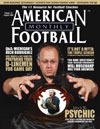AMERICAN FOOTBALL MONTHLY THE #1 RESOURCE FOR FOOTBALL COACHES
Article CategoriesAFM Magazine
|
The Speed Report: Maintaining Maximum Speed Capacity During the Seasonby: Dale BaskettFootball Speed Specialist © More from this issue In the July Speed Report on final preparations for in-season speed, I stressed maximizing speed prior to in-season. Now we are in-season and we must have a plan for sustaining the qualities we worked to develop. The key emphasis here is quality, not quantity. As I have put forward the last two years of writing the Speed Report, everything is quality, not quantity. Speed is a precision skill which must be trained in that manner. Too much emphasis on over working the physical aspects of training will degrade growth and maximum potential that can be produced and sustained. What’s the Prescription During Double Days? Hell week to football is a train wreck for speed skills. Young men go through physical demands that are more about physical conditioning than anything else. Coaches often use this time frame to i....The full article can only be seen by subscribers. Subscribe today!
|
|
|||||||
| HOME |
MAGAZINE |
SUBSCRIBE | ONLINE COLUMNISTS | COACHING VIDEOS |
Copyright 2025, AmericanFootballMonthly.com
All Rights Reserved





